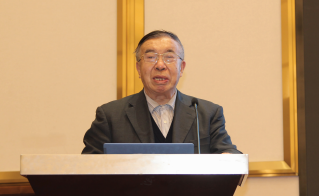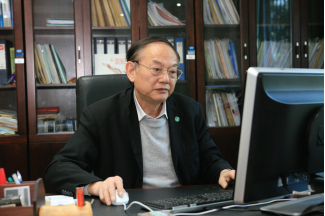Problems of soil salinization and drought and water shortage exist in a large area of cultivated land in Xinjiang, China.Introduction of mulching cultivation technology solves these problems and also brings residual film pollution.Based on research data on degree of residual film pollution in farmland in Xinjiang, advantages and disadvantages of typical technical equipment for mechanical residue film recycling in Xinjiang were summarized, reasonable suggestions have been put forward for problems existing in mechanized recovery technology of residual film in Xinjiang, providing a certain reference for research and development of residual film recovery machinery in Xinjiang.
Taking Santun River irrigation district of Changji Hui Autonomous Prefecture(hereinafter referred to as Changji Prefecture)in Xinjiang Uygur Autonomous Region(referred to as Xinjiang)as research area, hydrological analysis module of ArcGIS was used to extract river network water system of GDEMV3 30 m resolution digital elevation model, so as to obtain river network information such as flow direction, cumulative amount of confluence, hierarchical river network and sub-basin boundary.AI Earth deep learning algorithm was used to classify and extract Sentinel-1 SAR GRD remote sensing images.Different from traditional operation of using ENVI remote sensing image processing software to identify and classify surface objects of images in study area, this study prefered to use AI Earth to classify surface objects of Sentinel-2 L2A image data by using supervised classification algorithm, and then draw a canal system map to clearly and vividly show complex water structure of study area.The 17-grade Tiff data of GDEMV3 30 m resolution digital elevation data, field sampling point data, and selected area of earth map with 0.862 m/pixel and 672 tiles were processed to make canal system topography three-dimensional map of sampling point, and to deeply explore features of drainage geomorphology from a three-dimensional perspective to provide a more comprehensive perspective for the study.Difficulties encountered in course of experiment and solutions were discussed.
Semi closed greenhouse is a new greenhouse in recent years.Greenhouse climate corridor and positive pressure air supply system are the key system design of semi closed greenhouse.Temperature distribution uniformity and wind speed of air duct in semi closed greenhouse in summer were tested to verify greenhouse cooling capacity and performance of air supply system.Test results showed that, domestic fan SFG5-4 was equipped with 35 m long air duct, air supply was relatively uniform, and wind speed was from 4.3 m/s to 4.7 m/s; for temperature distribution rule, in the same horizontal direction, average temperature difference of each point in semi closed greenhouse was within range of 1.0 °C to1.8 °C, and in the same height direction, average temperature difference of each point in greenhouse was within range of 2.2 °C to 3.5 °C, and 3.5 m wet curtain was better than 2.0 m wet curtain in cooling effect.
Carbon emissions from livestock and poultry farming account for a large proportion of China's agricultural carbon emissions, and carbon emission reduction actions are urgent.Partial life cycle method was used to evaluate carbon emissions in production process of large-scale laying enterprises.Results showed that greenhouse gases mainly came from electricity consumption, manure treatment and fuel combustion.To reduce carbon emissions during poultry production process, efforts should be made to establish a carbon emission monitoring system, promote circular poultry production practices, focus on developing clean energy and energy-saving technologies, and fundamentally reduce carbon emissions.
Quality of seeds directly affects grain production, and screening of excellent seeds is of great significance to national food security.A univariate test was carried out on problem of uneven airflow distribution on sieve surface of 5XZ-10 specific gravity seed sorter.Using Fluent software, method of combining numerical simulation and experiment was used to solve flow field of heavy separator.To simplify amount of calculation, a porous media model was introduced instead of an airflow orifice plate.Parameters of porous medium model were solved by numerical fitting, geometric model of air chamber was established and feasibility of model was verified.Height scale coefficient of airflow orifice plate arrangement was
A apricot hot air drying control system based on machine vision was proposed, which used computer vision technology to detect and categorize apricots and automatically control temperature and wind speed in hot air drying process.The system used a neural network-based target detection algorithm to detect and segment apricots, extracted features of apricots using image processing technology, and classified apricots using YOLOv7.By adjusting parameters of temperature, wind speed and time of hot air drying, quality protection of apricot drying process was realized, which could maintain quality and taste of apricot and enhance economic value of dried apricot, and the system has certain application prospects.
Conventional water saving control for farmland irrigation mainly uses impact factor analysis to simulate accuracy of farmland irrigation to obtain a water saving control plan for farmland irrigation, ignoring impact of actual liquid limit and plastic limit variables of farmland soil on control plan, resulting in a low water saving coefficient of water saving control results.A water saving control method for farmland irrigation based on time-varying nonlinear characteristics and state variables was proposed.This method calculated time-varying nonlinear characteristics of basic parameters of farmland soil, calculated constraint conditions based on analyzed characteristics, established a target constraint function, and constructed a water saving control model for farmland irrigation, calculated target constraint conditions of state variables of farmland soil liquid limit and plastic limit to re evolve model, and obtained final water-saving control plan for farmland irrigation.Experimental results showed that water saving control results obtained after application of proposed method exhibited a high water saving coefficient, with an average of 0.477, water saving effect was good and met practical application needs of farmland irrigation.
Problems such as low output rate of scientific research and low originality of scientific research results in training process of existing agricultural engineering graduate students have frequently appeared, which has a greater impact on quality training of postgraduate education in China.In view of above problems, TRIZ innovation theory was introduced to conduct research and practice on teaching reform and innovation ability training mode of graduate students based on research objects of agricultural engineering graduate students of Henan University of Science and Technology, and four aspects of forward-looking and innovative grasp of graduate students' topic selection, deep-seated problem mining of scientific research, innovation model of research project research program methods, and innovation mechanism of postgraduate research incentives, were analyzed, aiming to enhance scientific research and innovation ability of graduate students.At the same time, it also could provide new ideas for education and training process of agricultural engineering graduate students in China.
From perspective of industrial integration, development characteristics of rice industry in Guiliuhe Town, Keyouqian Banner, Inner Mongolia Autonomous Region were analyzed.Suggestions and measures were proposed to increase farmers' income through all channels, promote integrated development of primary, secondary, and tertiary industries in rural areas, and promote development of town economy guided by advantageous characteristic industries.These suggestions and measures were to optimize rice industry, guide and promote flow of more capital, technology, talent and other elements to rural areas, encourage establishment of multiple interest linkage mechanisms and models between new business entities and farmers, expand multiple functions and values of agriculture, and strengthen brand building.








 京公网安备 11010502037498号
京公网安备 11010502037498号
